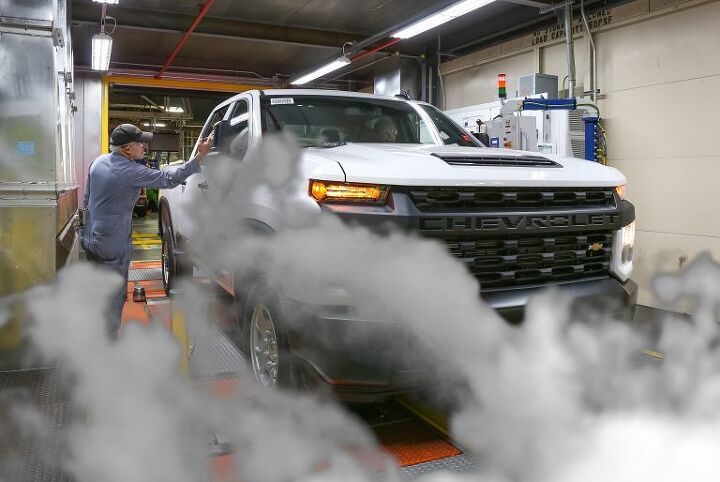#AutomotiveJobs
Drama at Volkswagen After CEO Suggests 30,000 Job Cuts
Volkswagen CEO Herbert Diess has been facing off with the company’s German workforce for weeks over the changing nature of the business. VW vowed to transition itself toward an all-electric lineup following the 2015 diesel emissions scandal. But the necessary steps to get there haven’t been universally appreciated.
The general assumption has always been that electric vehicles would result in massive layoffs across the industry by nature of their needing fewer parts than internal combustion vehicles. But Volkswagen seems worried that it’s falling behind smaller rivals and needs to take decisive action to make sure it’s not outdone by firms operating in the United States and China. The proposed solution is an industrial overhaul designed to fast-track VW’s electrification goals. Unfortunately, German labor unions are convinced that this plan would incorporate massive layoffs and have become disinclined to offer their support. The issue worsened in September when Diess told the supervisory board that a slower-than-desired transition to EVs could result in 30,000 fewer jobs.
Report: GM Needs More Manpower, UAW Suggests It Stop Drug Testing
Flint Truck Assembly is the only standing reminder of General Motors’ formerly impressive commitment to Genesee County, Michigan. Other representations include a myriad of crumbling factories that were closed decades ago and the area’s preponderance of vintage, high-mileage Buicks retained out of utility after the employment situation turned sour. Saying that the region has fallen upon hard times would be a grotesque understatement.
But that doesn’t mean there still aren’t still automotive jobs to be had. Despite GM reducing its Flint workforce from roughly 80,000 in the mid-1970s to fewer than 10,000 in 2010, the truck plant is still operational and reportedly looking for 450 temp workers to help fill in scheduling gaps for the 5,100 union-represented staffers it currently employs. Unfortunately, it’s been having trouble finding enough bodies, though the UAW has a solution. It believes that General Motors should stop drug testing, especially now that Michigan has legalized recreational marijuana use.
Keeping Tabs: Germany Promises One Million EV Charge Points by 2030
German Chancellor Angela Merkel announced Sunday that her country will soon have one million charging stations ready for electric cars. Her words came ahead of numerous meetings with German automotive manufacturers on how best to spur EV adoption in Europe.
Pivoting to zero-emission vehicles has many worried about job losses. The United Auto Workers issued a nearly 40-page report on the implications of electric vehicles and how to address them during its negotiations with General Motors — after the automaker said the battery plant it was eyeballing in Ohio would require hourly employees to take pay cuts. The Center for Automotive Research has also indicated that EVs simply don’t take as many man hours to manufacture. It’s even mentioned in the Trump administration’s fuel economy rollback proposal — an effort bent on furnishing cheap automobiles and American jobs.
Germany is worried too, with groups echoing similar employment concerns. To mitigate those fears, while encouraging electrification and maintaining jobs, the nation wants to take its 20,000 charging stations to 1 million.
Unifor Planning to Protest General Motors at Detroit Auto Show, UAW Boycotts Blazer
Things are starting to get truly ugly between Canada’s Unifor and General Motors. On Friday, the union held a rally in Windsor, Ontario, with that automaker’s headquarters just a river away. During the event, Unifor President Jerry Dias expressed his annoyance with the automaker’s restructuring plan and promised to bring the noise to GM’s front door during the North American International Auto Show this week.
Friday’s gathering, which Unifor and the Windsor and District Labour Council claimed drew around 2,000 people despite its brevity, focused primarily on the company’s decision to shift more of its North American production to Mexico and the shuttering of Oshawa Assembly and the end of this year. Dias said he wants the union to work with the automaker to keep Canadian jobs and avoid a potential boycott. Though that might be just around the corner, as the UAW has already issued a boycott of its own within the United States.
UAW Sues General Motors Over Temporary Workforce
Last week a lawsuit was filed with the U.S. District Court in Youngstown claiming that General Motors is in violation of a “memorandum of understanding” with the United Automobile Workers by allowing temporary employees to support the launch of some new product from Fort Wayne Assembly Plant. The facility, which is responsible for manufacturing the Chevrolet Silverado and GMC Sierra pickups, is alleged to have brought on temporary workers from May to August of 2018 instead of using its laid-off full-time workers. The UAW claims this is decision represents a breach of contract.
The union says there are nearly 700 workers laid off from the “nearby” Lordstown, Ohio Assembly Plant — many of whom have applied to transfer to the Fort Wayne as is their right under the current contract with GM.
Will the Fuel Efficiency Rollback Help Employment?
President Donald Trump was obsessed with U.S. employment long before being sworn in as Commander-in-chief. In fact, the jobs rhetoric played a major role in swaying traditionally democratic voters in states like Michigan. The promise of manufacturing positions, the kind of work American used to be known for, was too tempting for some living in the Rust Belt to ignore.
“We’re going to work on the CAFE standards so you can make cars in America again,” he told Detroit’s auto workers in March 2017, referencing the Corporate Average Fuel Economy. “We’re going to help the companies, and they’re going to help you.”
Those fuel economy rollbacks are now fast approaching, after the National Highway Traffic Safety Administration and Environmental Protection Agency released their official proposal last week. But will it truly help bolster employment rates in the United States? The answer depends largely upon who you ask.
The Interstate Battle Royale for Mazda and Toyota's Super Factory
The funny thing about job creators is that they don’t always, you know, create any jobs. So, when a business lets slip that it might have 4,000 positions on offer in the near future, every state with an unemployment rate higher than zero takes notice.
Mazda and Toyota’s joint factory — codenamed Project Mitt — is one such example, and now over a dozen U.S. states are simultaneously competing for the opportunity to host the $1.6-billion factory and the thousands of direct and indirect jobs it will yield.
When the Japanese automakers publicly revealed their cooperative venture a couple of weeks ago, they made it clear they had not yet picked a site — sending economic development offices into a frenzy. But what locale will emerge victorious has a lot to do with what the region can offer the manufacturer, including potential tax incentives, tempting job training programs, and investments into infrastructure.
An affordable and abundant workforce is also desirable — an element that distinguishes many states from one another. But no single area has everything on offer, leaving the final decision of where to build up in the air.






















Recent Comments